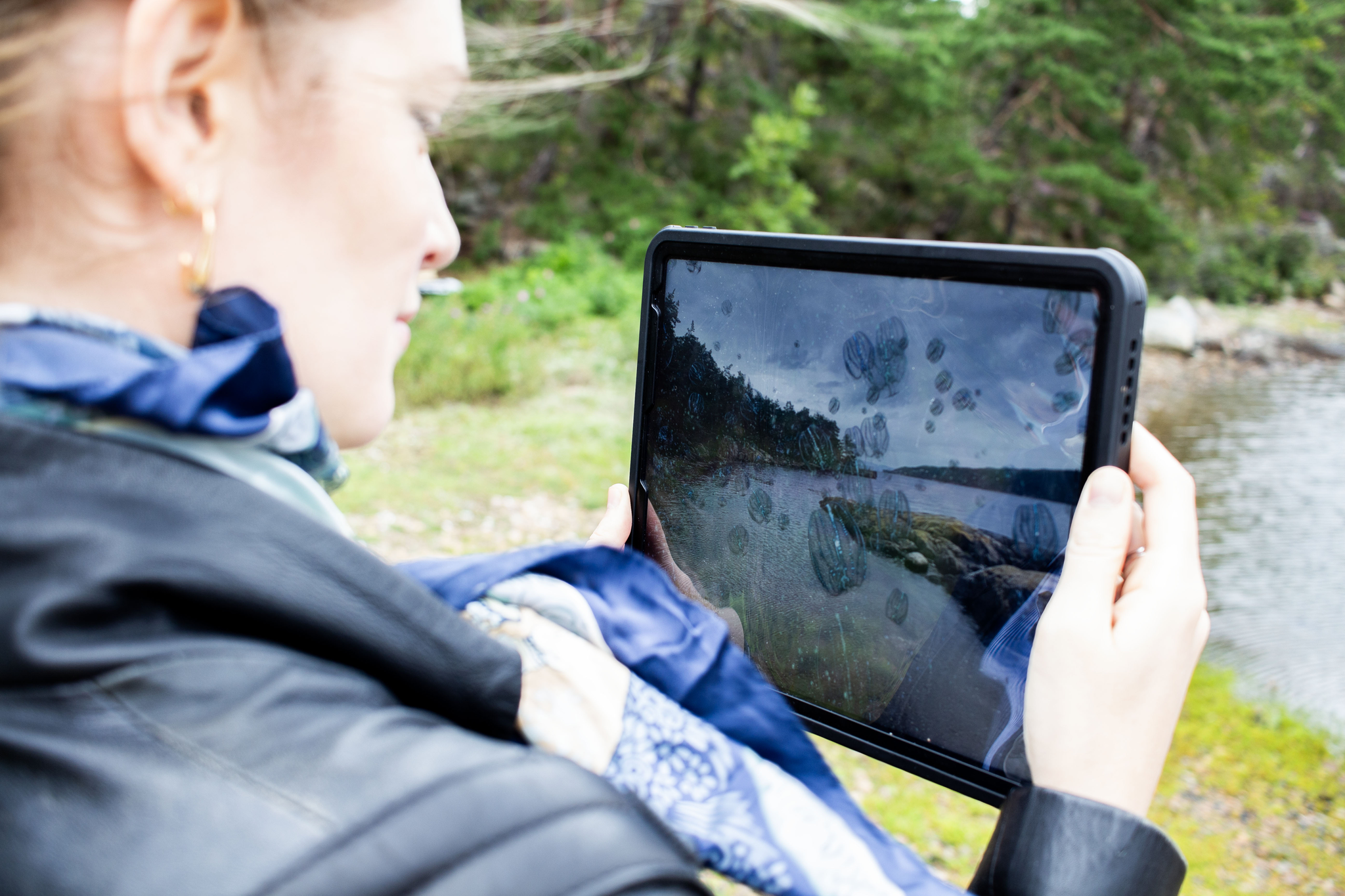Keywords: Interspecies Performance, Art in public space, Innstallation, New Materialism, Feminist Philosophy, Interspecies Temporality, More than human timescales, Art and technology
The ocean is dramatically changing; coastal ecosystems are in the process of adapting to new ocean realities. Fish populations are declining or migrating from their nested ecologies, while gelatinous ctenophores such as mnemiopsis leidyi (hereafter also referred to as ctenophora) and jellyfish seem to thrive and continue their cyclical survival choreographies. Scientists are predicting that the biomass of ctenophores and jellyfish will increase in the ocean, possibly with less biodiversity of other marine species. In other terms, oceans are becoming more gelatinous which already has, and will have an impact on intergenerational ways of connecting the sea and her inhabitants. The artistic research project Gelatinous Epistemes focuses on the ontological uncertainty of gelatinous oceans through a trans-local and trans-disciplinary engagement with the ctenophora. The project deploys choreography and expanded moving image practices to shed light on oceanic forms of communication and emerging ontologies.
In the project, ‘gelatinous epistemes’ will be researched and expressed through choreographic formations and moving image methodologies. I will study and document the already present hydro-choreographies of the ctenophora and interconnected humans in selected ecosystems with unique climate zones, collaborating with artists, fishermen, humanities scholars and scientists.
From this research, I will co-imagine and film new interspecies choreographies that speculatively merge human and more-than-human corporeal perspectives, thus actualising the real in new ways. For the final dissemination of the hydro-choreographic research, synchronization technology will be employed to interweave the research from the different sites into a multichannel video-installation and AR innstallation in public spaces.
The research is conducted in two climate zones/locations, both marked by human activity and the migration of ctenophora (the tempered cold zone of the Oslofjord/NO and Trondheimsfjor/ IT), as well as in a coastal fishing village where the ctenophora might migrate in the future (Berlevåg/NO now cold zone). In addition to the coastal locations the project will also be carried out in the context of the deep sea through involvement in the NTNU research project “Visualizing the Deep Sea in the Age of Climate Change” .
Research questions, each with an individual sub-question:
- What are the formations of ctenophores in the coastal and deep sea locations under scrutiny? What are the environmental and social contexts of these formations?
- How can expanded moving image practices be deployed to better understand the formations of ctenophores? How do they express the intimate human and non-human contact zones within the changing marine environments?
- How does the oceanic choreography of ctenophores translate into an audio-visual hydro-choreography that expands our imaginary of the ocean? How does artistic practice animate ocean ontologies?
Elly Vadseth is a norwegian- american interdisciplinary artist and PHD fellow at the institute of Art and Media studies at the Norwegian University of Science and Technolog where she is a member of the research groups “Deep Sea” and “Socially Engaged art”.
She holds an interdiciplanary MFA with a concentration in Media Arts and Performance/ choreography from the School of the Museum of Fine Arts at Tufts University (2018), Boston, USA, where she was awarded a Tufts Institute of the Environment fellow in artistic research (2018-2019) researching large scale public art works in and around rivers in Montana, USA with the organization Mountain Time Arts. The same year she was also awarded a Postgraduate teaching fellowship in Media Arts and video- performance at the School of the Museum of Fine Arts.
In embodied dialogue with discourses in artistic research, arthistory and environmental humanities her place-sensitive work and research circulate around sense-making and interspecies way-finding in shifting land and water ecologies.Vadseths interdiciplanry practice centers primarly around works within time based media, nonlinear multi channel video, virtual installations and art in public space.
Her work has been presented internationally in exhibitions, performances, screenings, publications, large-scale outdoor and indoor public works. Recently at F15 (NO), Fulcrum Festival (LA), Bevilacqua La Masa/Venetian Foundation (with Boris kourtoukov), The National Museum of Science and technology (NO), Henie Onstad contemporary art center (NO), The Museum of Fine Arts (USA) and Mountain time arts (USA). She was a recipient of a Postgraduate teaching fellowship in media arts at the School of the Museum of Fine Arts at Tufts University (2018-2019) and recently designed and tought the arthistory course Interspecies Worldmaking: Art, plants and animals.
Project Links:
- ntnu.edu/deepsea
- esvkunst.com
- ntnu.no/ansatte/elly.s.vadseth
- https://thecpr.org.uk/product/interspecies-performance/ chapter recently published in the book Interspecies Performance co-written with PHD fellow Florence Fitzgerald-Allsopp, University of Surrey, 2024
Hydro-choreographic worldmaking
In my second presentation I will articulate and reflect on current methods and work processes at the intersection of expanded choreographic practice and expanded moving image. I will give a brief presentation of the core of the project before diving into my first completed artistic result, the virtual innstallation and hydrochoreography “Migratory Bodies, Gelatinous time” which is co-created with my collaborator Boris Kourtoukov. During the presentatation I will illumniate current ethical dimensions concerning technology, collaboration and more than human representation.
In my first presentation I will present my project which sits at the intersection of artistic research and research in the environmental humanities. I will give the audience insight into the conceptual ideas of the project and the processes planned and map out the the placement of the research in relation to an interdisciplinary feminist artistic research field, nationally and internationally. I will also reflect on how the project potentially can contribute to the development of this field sharing preliminary movement research showed through movement, video and sound.
